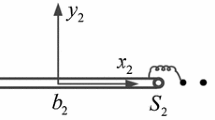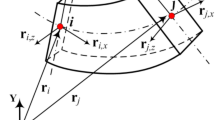Abstract
An adaptive sparse polynomial chaos (PC) transfer matrix method (TMM) is proposed to study the dynamics modeling and analysis of probabilistic uncertain beam systems with geometric nonlinearity and thermal coupling effect. Based on the floating reference frame and the nonlinear elasticity theory, the dynamics equations of flexible beam with geometric nonlinearity and thermal coupling effect are deduced firstly, and then, its transfer equations and transfer matrices and that of the involved hinge elements are established, which can be used to assemble the overall transfer equation of beam system easily according to the system’s topological structure. For a deterministic system, the dynamics of system can be obtained by solving the coupled transfer equation and transient heat conduction equation easily. The proposed TMM doesn’t need the global differential–algebraic equation of system and greatly reduces the involved matrix order and calculation cost, so it is very useful for improving the valuation efficiency of the design of experiment in the subsequent uncertain analysis. When considering the stochastic parameters, above equations are all uncertain equations. Based on the hyperbolic basis truncation scheme, the least angle regression algorithm, and the posteriori cross-validation error estimation method, a nonintrusive adaptive sparse PC expansion method is adopted for uncertain analysis, which only needs a small number of model evaluations and could further reduce the calculation cost of uncertain analysis. The numerical simulation is presented to validate the correctness, feasibility, and computational efficiency of this method. By deducing new transfer equations of related body/hinge, this research can be extended to the dynamics modeling and analysis for general rigid–flexible–thermal coupling multibody systems with probabilistic uncertainties.















Similar content being viewed by others
Data availability
Data sharing not applicable, as this article describes a method of dynamics modeling and analysis, and the data supporting this study have been available within the article.
References
Schiehlen, W.: Research trends in multibody system dynamics. Multibody Syst. Dyn. 18(1), 3–13 (2007)
Rong, B., Rui, X.T., Tao, L., et al.: Theoretical modeling and numerical solution methods for flexible multibody system dynamics. Nonlinear Dyn. 98(2), 1519–1553 (2019)
Liu, J.Y., Lu, H.: Thermal effect on the deformation of a flexible beam with large kinematical driven overall motions. Eur. J. Mech. A Solids 26(1), 137–151 (2007)
Li, T.J., Wang, Y.: Deployment dynamic analysis of deployable antennas considering thermal effect. Aerosp. Sci. Technol. 13(4–5), 210–215 (2009)
Čepon, G., Starc, B., Zupančič, B., et al.: Coupled thermo-structural analysis of a bimetallic strip using the absolute nodal coordinate formulation. Multibody Syst.Dyn. 41, 391–402 (2017)
Cui, Y.Q., Yu, Z.Q., Lan, P.: A novel method of thermo-mechanical coupled analysis based on the unified description. Mech. Mach. Theory 134, 376–392 (2019)
Wei, L.H., Huang, A.Y., Deng, C.Z.: Dynamics and thermal impact response analysis of the hub and beam coupled system with tip mass. Mech. Sci. Technol. Aerosp. Eng. 27(10), 1236–1241 (2008)
Liu, J.Y., Pan, K.Q.: Dynamics investigation of composite flexible multi-body system considering terminal effect. J. Dyn. Control 7(1), 9–13 (2009)
Shen, Z.X.: Thermally Induced Vibrations of Large-Scale Space Multi-body Structures Based on the Absolute Coordinate, Beijing Institute of Technology, Doctoral Dissertation (2014)
Zhang, B., Li, Y.M., Lu, WZh.: Dynamic characteristics of rotating pretwisted clamped-clamped beam under thermal stress. J. Mech. Sci. Technol. 30, 4031–4042 (2016)
Shen, Zh.X., Li, H.J., Liu, X.N., et al.: Thermal shock induced dynamics of a spacecraft with a flexible deploying boom. Acta Astronaut. 141, 123–131 (2017)
Petzke, F., Mesbah, A., Streif, S.: PoCET: a polynomial chaos Expansion toolbox for Matlab. In: Proceedings of 21st IFAC World Congress (2020)
Shen, W.: Exploration and Generalization of Several Stepwise Variable Selection Algorithms. Shandong University (2016)
Yu, L.H., Zhao, J.X.: Design of sparse MIMO equalizers using least angle regression. J. Xidian Univ. 46(1), 73–78 (2019)
Blatman, G.: Adaptive Sparse Polynomial Chaos Expansion for Uncertainty Propagation and Sensitivity Analysis. Ph.D. Thesis, Blaise Pascal University - Clermont II (2009)
Gupta, V., Mittal, M.: QRS complex detection using STFT, chaos analysis, and PCA in standard and real-time ECG databases. J. Inst. Eng. 100, 489–497 (2019)
Gupta, V., Mittal, M., Mittal, V.: Chaos theory and ARTFA: emerging tools for interpreting ECG signals to diagnose cardiac arrhythmias. Wirel. Pers. Commun. 118(2), 3615–3646 (2021)
Gupta, V., Mittal, M., Mittal, V.: R-peak detection based chaos analysis of ECG signal. Analog Integr. Circ. Sig. Process 102(3), 479–490 (2020)
Müller, A.: Screw and Lie group theory in multibody dynamics recursive algorithms and equations of motion of tree-topology systems. Multibody Syst. Dyn. 42, 219–248 (2018)
Sun, H.L.: Research on Recursive Dynamics of Rigid-Flexible-Liquid Coupling Mechanical Multibody Systems, Ph.D. Dissertation, Nanjing University of Aeronautics and Astronautics (2011)
Kingsley, C., Poursina, M.: Extension of the divide-and-conquer algorithm for the efficient inverse dynamics analysis of multibody systems. Multibody Syst.Dyn. 42(2), 145–167 (2018)
Rui, X.T., He, B., Lu, Y.Q., et al.: Discrete time transfer matrix method for multibody system dynamics. Multibody Syst. Dyn. 14(3–4), 317–344 (2005)
Rong, B., Rui, X.T., Tao, L., et al.: Dynamics analysis and fuzzy anti-swing control design of overhead crane system based on Riccati discrete time transfer matrix method. Multibody Syst.Dyn. 43(3), 279–295 (2018)
Rui, X.T., Rong, B., Wang, G.P., et al.: Discrete time transfer matrix method for dynamics analysis of complex weapon systems. Sci. China Technol. Sci. 54(5), 1061–1071 (2011)
Zhang, J.S., Rui, X.T., Liu, F.F., et al.: Substructuring technique for dynamics analysis of flexible beams with large deformation. J. Shanghai Jiao Tong Univ. (Sci.) 22(5), 562–569 (2017)
Rui, X., Bestle, D.: Reduced multibody system transfer matrix method using decoupled hinge equations. Int. J. Mech. Syst. Dyn. 1(2), 182–193 (2021)
Rui, X.T., Zhang, J.S., Wang, X., et al.: Multibody system transfer matrix method: the past, the present, and the future. Int. J. Mech. Syst. Dyn. 2(1), 3–26 (2022)
Rui, X.T., Bestle, D., Zhang, J.S., et al.: A new version of transfer matrix method for multibody systems. Multibody Syst.Dyn. 38, 137–156 (2016)
Guo, Y.M., Tao, W.M., Zhuang, Zh.: Linear and nonlinear finite elements and their applications. China Machine Press, Beijing (2004)
Liu, J.Y., Hong, J.Z.: Dynamic modeling theory and finite element method for a rectangular plate undergoing large overall motion. J. Vib. Eng. 16(2), 175–179 (2003)
Shabana, A.A.: Dynamics of Multibody Systems, 3rd edn. Cambridge University Press, New York (2008)
Bauchau, O.A.: Flexible Multibody Dynamics. Springer, New York (2011)
Zhang, J.S., Rui, X.T., Gu, J.J.: Eigenvalue analysis of the stress stiffening effect for a curved beam with large rigid motion. J. Vib. Eng. 29(5), 779–786 (2016)
Nickell, R.E.: Nonlinear dynamics by mode superposition. Comput. Methods Appl. Mech. Eng. 7(1), 107–129 (1976)
Herkt, S.: Model Reduction of Nonlinear Problems in Structural Mechanics: Towards a Finite Element Type Model for Multibody Simulation. PhD Thesis, TU Kaiserslautern, FB Mathematik (2008)
Blatman, G., Sudret, B.: Adaptive sparse polynomial chaos expansion based on least angle regression. J. Comput. Phys. 230(6), 2345–2367 (2011)
UQLab, The Framework for Uncertainty Quantification. https://www.uqlab.com
Zhang, J.S.: Study on Some Issues of the New Version of Transfer Matrix Method for Multibody Systems. PhD Thesis, Nanjing University of Science and Technology (2017)
Acknowledgements
The research was supported by the National Natural Science Foundation of China (Grant No: 11702292).
Author information
Authors and Affiliations
Corresponding author
Ethics declarations
Conflict of interest
The authors declared that they have no conflicts of interest to this work. We do not have any commercial or associative interest that represents a conflict of interest in connection with the work submitted. The work described has not been submitted elsewhere for publication, in whole or in part, and all the authors listed have approved the manuscript that is enclosed.
Additional information
Publisher's Note
Springer Nature remains neutral with regard to jurisdictional claims in published maps and institutional affiliations.
Appendix
Appendix
It must be pointed out that, in this study, the product quantities higher than second-order related to the deformed generalized coordinates are ignored, which have little effect on the calculation accuracy in most cases.
Rights and permissions
Springer Nature or its licensor holds exclusive rights to this article under a publishing agreement with the author(s) or other rightsholder(s); author self-archiving of the accepted manuscript version of this article is solely governed by the terms of such publishing agreement and applicable law.
About this article
Cite this article
Rong, B., Rui, X., Tao, L. et al. Efficient dynamics modeling and analysis for probabilistic uncertain beam systems with geometric nonlinearity and thermal coupling effect. Nonlinear Dyn 111, 39–66 (2023). https://doi.org/10.1007/s11071-022-07836-2
Received:
Accepted:
Published:
Issue Date:
DOI: https://doi.org/10.1007/s11071-022-07836-2




